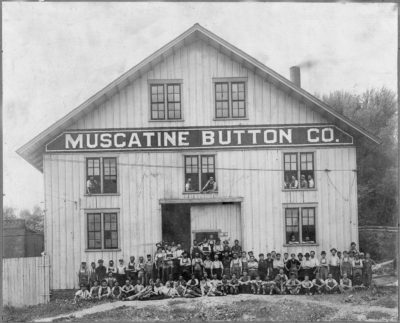
Laborers at the Muscatine Button Company pose for a photo in 1910. Photo courtesy of the Oscar Grossheim Collection at Musser Public Library
The 1911 labor revolt that shook the Pearl Button Capital of the World
By Tim Phillips
By 1905, Muscatine was known as the Pearl Button Capital of the World, producing 1.5 billion pearl buttons per year, which accounted for approximately 37 percent of the world’s buttons. But within 10 years of the button industry’s launch in Muscatine, the first signs of tension between union workers and manufacturers surfaced and in 1911 a full-fledged strike arose that would stay with residents for years to come.
Muscatine became home to the world’s first fresh water pearl button factory in 1891 shortly after the arrival of German immigrant and button cutter John Frederick Boepple, whose financial partner was William Molis of Muscatine. Boepple’s factory used simple foot-powered lathes that were modified from their original purpose of cutting ocean pearls in Germany to cut, carve designs and drill holes into the thick mussel shells that were abundant in the Mississippi River.
By 1897, button cutting and mussel fishing (clammers and their families set up camps along the river) were booming businesses as there were three large button factories in Muscatine and dozens of smaller family shops that dug clams out of the river shallows and cut buttons in woodshed-size factories that dotted the community. The introduction of an efficient button making machine in 1900 known as the Double Automatic (capable of producing more than 150 gross, or 21,600 buttons per day) and other mechanical inventions helped increase production so that by 1911 there were 43 factories. The factories varied in size as some cut button blanks, while others were finishing plants and only a few of the largest plants carried out every step of the process. Though the button industry was made up of many different employers, it was tight-knit.
Nine short strikes occurred in Muscatine between July 1899 and November 1900, with the longest work stoppage lasting 61 days. All of the strikes were instigated by workers at individual factories, not by a union.
About 10 years later, a state labor commission cited fire traps, unsanitary conditions and unguarded machinery among the greatest threats to worker safety and health at button factories in Muscatine. It also noted the long hours required of workers as the button industry ranked first in the number of employees working 54 to 60 hours a week and third highest in the number of workers employed for more than 72 hours a week.
TO READ MORE ABOUT THIS STORY AND OTHER FASCINATING STORIES ABOUT IOWA HISTORY, subscribe to Iowa History Journal. You can also purchase back issues at the store.
